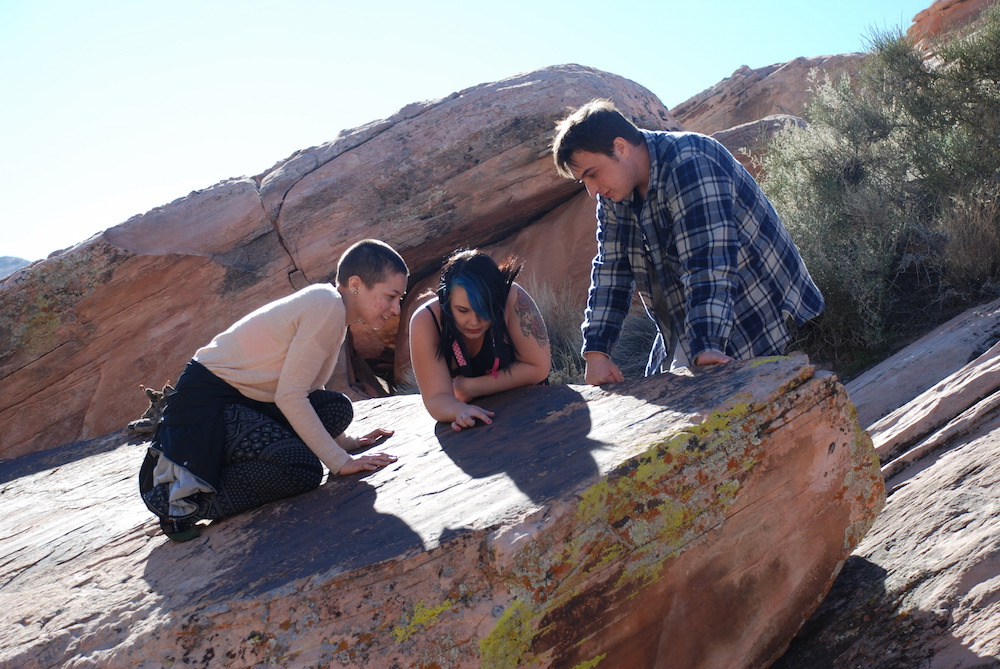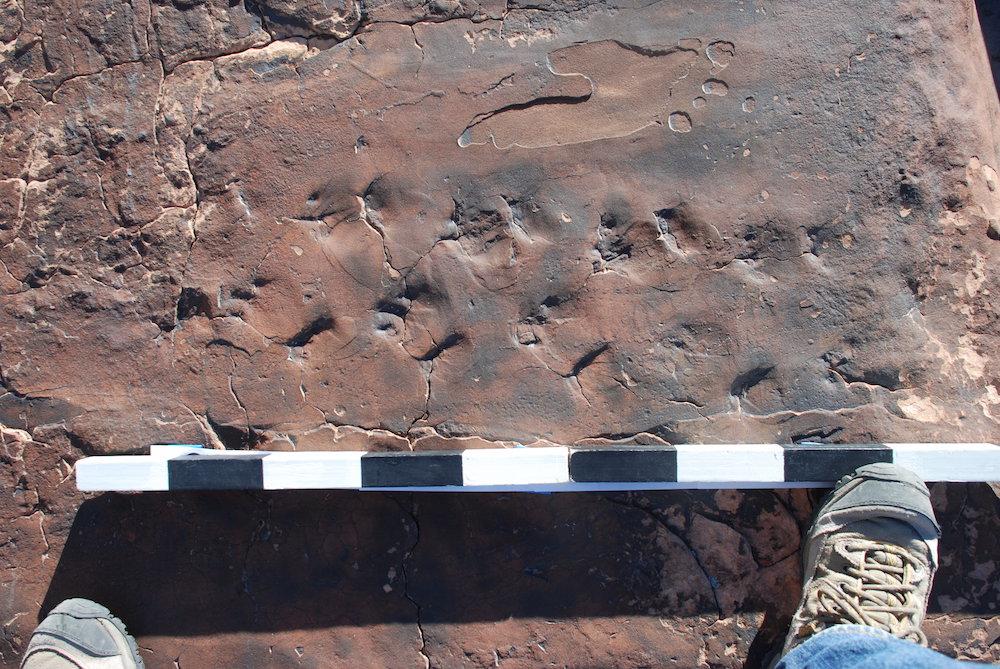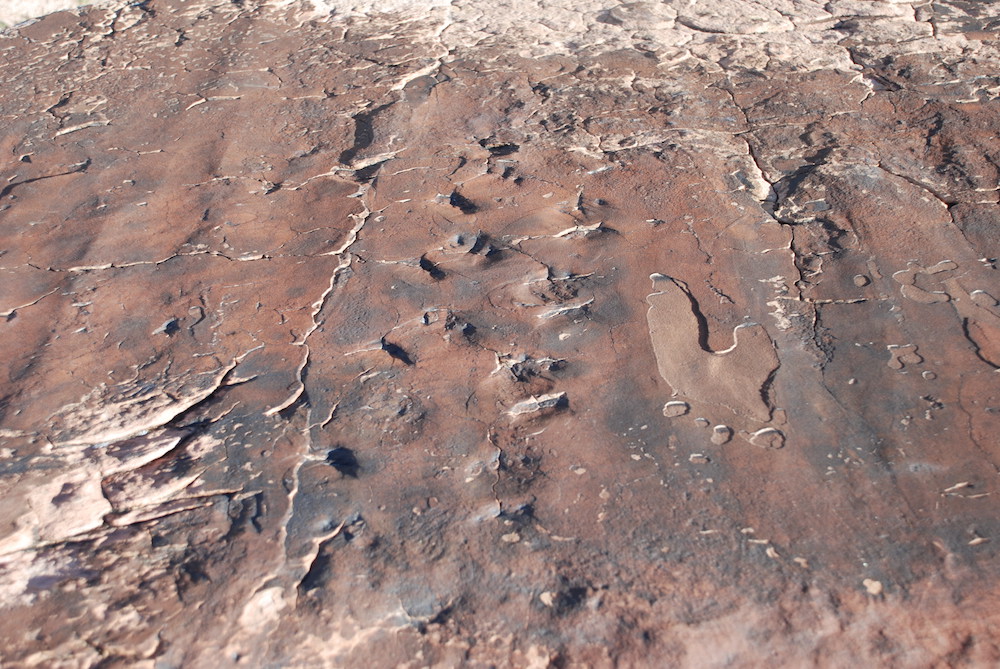Jackpot! Hiker Discovers Ancient Reptile Footprints Near Las Vegas

SALT LAKE CITY — About 290 million years ago, a four-legged reptile with three toes on each of its back feet strolled across the mucky land, the waves of a tidal flat likely lapping near its feet, a new study finds.
The ancient environment preserved this creature's footprints in a fossilized trackway that researchers are calling Chelichnus gigas. (Scientists name trackways like they do new species.) However, although researchers have a clear view of the animal's back feet, the shape of its front feet remains a mystery.
That's because like many four-legged (or tetrapodal) animals, this ancient critter's back feet would have stepped directly on top of the freshly made footprints of its front feet, meaning that the front footprints are obscured by the back ones, said study lead researcher Stephen Rowland, a professor of geology at the University of Nevada, Las Vegas. [5 Fossil Hotspots: National Parks to Visit]
"The hind footprints are superimposed on the front footprints, so we don't have well-preserved front footprints," Rowland told Live Science. But there are "three digits on the most distinctive [rear] ones," he added.

Amateur paleontologist Tom Cluff found the ancient footsteps by accident a few years ago while he was hiking in southern Nevada's Clark County with two friends. Cluff planned to show them a fossilized invertebrate track he had found earlier. When they sat down for a picnic lunch that day, they noticed the reptile's tracks fossilized on a rock slab below, Cluff told Live Science.
Cluff told Rowland of the discovery, and the professor soon set out with his students to study the trackway. In all, the trackway includes six strides, with an average stride length of 6 inches (15 centimeters), Rowland said.
Each footprint is about 3.5 inches wide by about 4 inches long (8.8 by 10.1 cm), and the entire trackway measures about 7.4 inches (19 cm) long, he added.
Sign up for the Live Science daily newsletter now
Get the world’s most fascinating discoveries delivered straight to your inbox.
However, it's hard to say what species of animal left the prints. It was likely an early reptile, about 2 feet (60 cm) long, similar to Dimetrodon, which lived before the dinosaurs during the Permian period, Rowland said. But Dimetrodon's tracks are different from the ones Rowland and the team are studying, he noted.
Moreover, "the early Permian was a time when the reptiles were really diversifying," Rowland said, so it's possible the footprints belong to a creature that has yet to be identified.
The trackway provides clues about the species, however. For instance, there's no evidence of a tail dragging behind the creature, suggesting it either didn't have one or that it was held aloft, Rowland said. Also, the fossil retains some ripple marks, indicating that the animal was walking along a tidal flat, rather than in a dry desert, Rowland said.
Preserving footsteps

The tidal flat probably played a role in the trackway's preservation, Rowland said. The animal may have walked on top of a thin film of bacteria near the water called a microbial mat, he said.
"When you have that mat, it's like a thin layer of cellophane," he said. "When an animal walks on it, it makes an impression in the cellophane. Even though new sediment comes on top of it, the old print is preserved underneath the new sediment because of that thin biofilm."
Over hundreds of millions of years, the layers built up and then eroded from the footprints, "but because of that biofilm, we have a beautiful exposure of a track from 290 million years ago," Rowland said. [Photos: Giant Sauropods Plodded Along in Scottish Lagoon]
Though small, the C. gigas trackway is larger than fossilized trackways found in the famous Coconino Sandstone in the Grand Canyon region, he added. What's more, it's several million years older than many of the trackways in the surrounding Colorado plateau region, Rowland said.
However, it's not the oldest reptile trackway; that honor goes to tiny footprints left by a reptile that lived about 318 million years ago in what is now New Brunswick, Canada.
The study, which has yet to be published in a peer-reviewed journal, was presented Thursday (Oct. 27) here at the 2016 Society of Vertebrate Paleontology meeting.
Original article on Live Science.

Laura is the archaeology and Life's Little Mysteries editor at Live Science. She also reports on general science, including paleontology. Her work has appeared in The New York Times, Scholastic, Popular Science and Spectrum, a site on autism research. She has won multiple awards from the Society of Professional Journalists and the Washington Newspaper Publishers Association for her reporting at a weekly newspaper near Seattle. Laura holds a bachelor's degree in English literature and psychology from Washington University in St. Louis and a master's degree in science writing from NYU.









